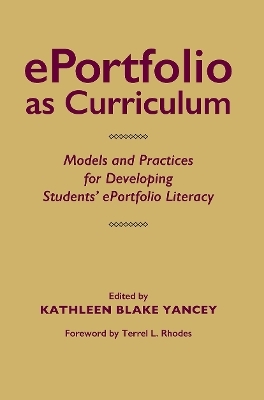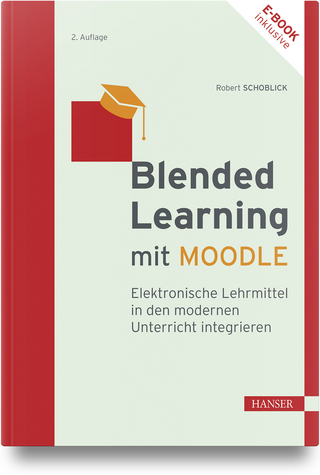
ePortfolio as Curriculum
Stylus Publishing (Verlag)
978-1-62036-759-9 (ISBN)
At a moment when the ePortfolio has been recognized as a high impact practice – as a unique site for hosting student integrative learning and as a powerful genre for assessment – this book provides faculty, staff, and administrators with a set of frameworks and models useful for guiding students in designing and creating ePortfolios that clearly communicate their purpose and effectively use the affordances of the medium.In short, this book both illustrates and provides guidance on how to support the development of students’ ePortfolio literacy. The ePortfolio curricular models provided in ePortfolio as Curriculum include both those integrated within existing disciplinary courses and those offered through credit-bearing stand-alone courses.In taking up questions focused on what students need to know and do in becoming informed, effective ePortfolio makers, the contributors to this volume – from the standpoint of their course outcomes and institutional contexts – present various approaches to developing an ePortfolio curriculum. Individually and collectively, the chapters explain ways to engage students in understanding the potential purposes, structures, audiences, and designs of ePortfolios; in developing the reflective practices for contextualizing and informing the selection and curation of artifacts; and in creating appropriate focus and coherence.Synthesizing insights from the previous chapters, the concluding chapter identifies six consistent features of an ePortfolio curriculum that support the development of students' ePortfolio literacy. In addition, Kathleen Blake Yancey identifies and defines seven common ePortfolio curricular dimensions that contribute to students' ePortfolio literacy, among them student agency, digital identity, and campus and global citizenship. Not least, she describes new practices emerging from ePortfolio curricula, including new ePortfolio-specific genres; new metaphors used to characterize ePortfolios and their practices; and new issues that the ePortfolio curriculum raises.
Kathleen Blake Yancey is Kellogg W. Hunt Professor of English and Distinguished Research Professor at Florida State University. She has focused her research agenda on portfolios for the life of her career. In 1992, she published Portfolios in the Writing Classroom; in 1996, the co-edited Situating Portfolios, in 2001, the co-edited Electronic Portfolios: Emerging Practices in Student, Faculty and Institutional Learning; and in 2009, the co-edited Electronic Portfolios 2.0: Emergent Research on Implementation and Impact. She has served on the AAC&U VALUE Steering Committee and on the Board of Directors for the Association for Authentic, Experiential and Evidence-based Learning (AAEEBL), and she is a faculty member for WASC’s Assessment Leadership Academy and a mentor for WASC’s Community of Practice project. Yancey has also been the president or chair of several writing studies/literacy organizations, including the Council of Writing Program Administrators (CWPA), the Conference on College Composition and Communication (CCCC), and the National Council of Teachers of English (NCTE). Immediate Past Editor of College Composition and Communication, and past co-editor of the journal Assessing Writing, she has published over 100 refereed articles and book chapters and authored, edited, or co-edited 15 scholarly books, most recently Writing Across Contexts: Transfer, Composition, and Sites of Writing; and A Rhetoric of Reflection. She has been recognized with several awards, including the CWPA Best Book Award, the CCCC Research Impact Award, the FSU Graduate Mentor Award, the FSU Graduate Teaching Award, and the CCCC Exemplar Award. Terrel L. Rhodes, Vice President, Office of Quality, Curriculum and Assessment; and Executive Director of VALUE- Association of American Colleges and Universities
Foreword—Terrel L. Rhodes Acknowledgments Introduction. ePortfolio as Curriculum. Models and Practices—Kathleen Blake Yancey 1. ePortfolio-as-Curriculum. Revisualizing the Composition Process—Amy Cicchino, Rachel Efstathion, and Christina Giarrusso 2. Collateral Learning as an ePortfolio Curriculum—Sharon Burns and Jo Ann Thompson 3. ePortfolios in a World Language Learning Curriculum—Karen Simroth James, Emily E. Scida, Yitna Firdyiwek 4. Hampshire College ePortfolios. A Curriculum on Reflection to Support Individualized Educational Pathways—Laura Wenk 5. Identity Development as Curriculum. A Metacognitive Approach—Susan Kahn 6. Untangling the Past and Present While Weaving a Future. ePortfolios as a Space for Professional Discernment and Growth—Gail Matthews-DeNatale 7. Limiting ePortfolio Requirements, Raising Student Energy. Establishing a Culture of Student Advocacy for ePortfolio Programs—Sue Denning 8. Creating an ePortfolio Studio Experience. The Role of Curation, Design, and Peer Review in Shaping ePortfolios—Kathleen Blake Yancey 9. Macaulay Springboards. The Capstone as an Open Learning ePortfolio—Joseph Ugoretz 10. Metacognition Across the Curriculum. Building Capstone ePortfolios in Stanford University’s Notation in Science Communication—Jennifer Stonaker, Jenae Druckman Cohn, Russ Carpenter, Helen L. Chen 11. The Invited ePortfolio Curriculum—Katherine Bridgman 12. Integrative Learning and ePortfolio Networks—Cheryl Emerson and Alex Reid 13. Concluding Forward—Kathleen Blake Yancey About the Contributors Index
| Erscheinungsdatum | 25.04.2019 |
|---|---|
| Sprache | englisch |
| Maße | 152 x 229 mm |
| Gewicht | 544 g |
| Themenwelt | Schulbuch / Wörterbuch ► Unterrichtsvorbereitung ► Unterrichts-Handreichungen |
| Sozialwissenschaften ► Pädagogik ► Bildungstheorie | |
| Sozialwissenschaften ► Pädagogik ► Erwachsenenbildung | |
| ISBN-10 | 1-62036-759-9 / 1620367599 |
| ISBN-13 | 978-1-62036-759-9 / 9781620367599 |
| Zustand | Neuware |
| Haben Sie eine Frage zum Produkt? |
aus dem Bereich


